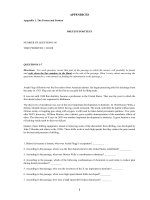Materials Data Book- 2003 Edition
Bạn đang xem bản rút gọn của tài liệu. Xem và tải ngay bản đầy đủ của tài liệu tại đây (792.42 KB, 41 trang )
1
Materials
Data
Book
2003 Edition
Cambridge University Engineering Department
2
PHYSICAL CONSTANTS IN SI UNITS
Absolute zero of temperature
– 273.15 °C
Acceleration due to gravity, g 9. 807 m/s
2
Avogadro’s number,
A
N
6.022x10
26
/kmol
Base of natural logarithms, e 2.718
Boltzmann’s constant, k 1.381 x 10
–26
kJ/K
Faraday’s constant, F 9.648 x 10
7
C/kmol
Universal Gas constant,
R
8.3143 kJ/kmol K
Permeability of vacuum, µ
o
1.257 x 10
–6
H/m
Permittivity of vacuum, ε
o
8.854 x 10
–12
F/m
Planck’s constant, h 6.626 x 10
–37
kJ/s
Velocity of light in vacuum, c 2.998 x 10
8
m/s
Volume of perfect gas at STP 22.41
m
3
/kmol
CONVERSION OF UNITS
Angle,
θ
1 rad
57.30 °
Energy, U See inside back cover
Force, F 1 kgf
1 lbf
9.807 N
4.448 N
Length,
l
1 ft
1 inch
1 Å
304.8 mm
25.40 mm
0.1 nm
Mass, M 1 tonne
1 lb
1000 kg
0.454 kg
Power, P See inside back cover
Stress, σ
See inside back cover
Specific Heat, C
p
1 cal/g.°C
4.188 kJ/kg.K
Stress Intensity, K
1 ksi
in
1.10 MPa
m
Temperature, T
1 °F
0.556 K
Thermal Conductivity, λ
1 cal/s.cm.
o
C 4.18 W/m.K
Volume, V 1 Imperial gall
1 US gall
4.546 x 10
–3
m
3
3.785 x 10
–3
m
3
Viscosity, η
1 poise
1 lb ft.s
0.1 N.s/m
2
0.1517 N.s/m
2
1
CONTENTS
Page Number
Introduction 3
Sources 3
I. FORMULAE AND DEFINITIONS
Stress and strain 4
Elastic moduli 4
Stiffness and strength of unidirectional composites 5
Dislocations and plastic flow 5
Fast fracture 6
Statistics of fracture 6
Fatigue
7
Creep 7
Diffusion 8
Heat flow 8
II. PHYSICAL AND MECHANICAL PROPERTIES OF MATERIALS
Melting temperature 9
Density 10
Young’s modulus 11
Yield stress and tensile strength 12
Fracture toughness 13
Environmental resistance 14
Uniaxial tensile response of selected metals and polymers 15
III. MATERIAL PROPERTY CHARTS
Young’s modulus versus density 16
Strength versus density 17
Young’s modulus versus strength 18
Fracture toughness versus strength 19
Maximum service temperature 20
Material price (per kg) 21
IV. PROCESS ATTRIBUTE CHARTS
Material-process compatibility matrix (shaping) 22
Mass 23
Section thickness 23
Surface roughness 24
Dimensional tolerance 24
Economic batch size 25
2
V. CLASSIFICATION AND APPLICATIONS OF ENGINEERING MATERIALS
Metals: ferrous alloys, non-ferrous alloys 26
Polymers and foams 27
Composites, ceramics, glasses and natural materials 28
VI. EQUILIBRIUM (PHASE) DIAGRAMS
Copper – Nickel 29
Lead – Tin 29
Iron – Carbon 30
Aluminium – Copper 30
Aluminium – Silicon 31
Copper – Zinc 31
Copper – Tin 32
Titanium-Aluminium 32
Silica – Alumina 33
VII. HEAT TREATMENT OF STEELS
TTT diagrams and Jominy end-quench hardenability curves for steels 34
VIII. PHYSICAL PROPERTIES OF SELECTED ELEMENTS
Atomic properties of selected elements 36
Oxidation properties of selected elements 37
3
INTRODUCTION
The data and information in this booklet have been collected for use in the Materials Courses in
Part I of the Engineering Tripos (as well as in Part II, and the Manufacturing Engineering
Tripos). Numerical data are presented in tabulated and graphical form, and a summary of useful
formulae is included. A list of sources from which the data have been prepared is given below.
Tabulated material and process data or information are from the Cambridge Engineering Selector
(CES) software (Educational database Level 2), copyright of Granta Design Ltd, and are
reproduced by permission; the same data source was used for the material property and process
attribute charts.
It must be realised that many material properties (such as toughness) vary between wide limits
depending on composition and previous treatment. Any final design should be based on
manufacturers’ or suppliers’ data for the material in question, and not on the data given here.
SOURCES
Cambridge Engineering Selector software (CES 4.1), 2003, Granta Design Limited, Rustat
House, 62 Clifton Rd, Cambridge, CB1 7EG
M F Ashby, Materials Selection in Mechanical Design, 1999, Butterworth Heinemann
M F Ashby and D R H Jones, Engineering Materials, Vol. 1, 1996, Butterworth Heinemann
M F Ashby and D R H Jones, Engineering Materials, Vol. 2, 1998, Butterworth Heinemann
M Hansen, Constitution of Binary Alloys, 1958, McGraw Hill
I J Polmear, Light Alloys, 1995, Elsevier
C J Smithells, Metals Reference Book, 6
th
Ed., 1984, Butterworths
Transformation Characteristics of Nickel Steels, 1952, International Nickel
4
I. FORMULAE AND DEFINITIONS
STRESS AND STRAIN
A
F
t
=
σ
o
A
F
n
=
σ
=
o
t
l
l
ln
ε
o
o
n
l
ll −
=
ε
F
= normal component of force
t
σ
= true stress
o
A = initial area
n
σ
= nominal stress
A = current area
t
ε
= true strain
o
l = initial length
n
ε
= nominal strain
l
= current length
Poisson’s ratio,
strainallongitudin
strainlateral
−=
ν
Young’s modulus E = initial slope of
tt
εσ
−
curve = initial slope of
nn
εσ
−
curve.
Yield stress
y
σ
is the nominal stress at the limit of elasticity in a tensile test.
Tensile strength
ts
σ
is the nominal stress at maximum load in a tensile test.
Tensile ductility
f
ε
is the nominal plastic strain at failure in a tensile test. The gauge length of
the specimen should also be quoted.
ELASTIC MODULI
)1(2
ν
+
=
E
G
)21(3
ν
−
=
E
K
For polycrystalline solids, as a rough guide,
Poisson’s Ratio
3
1
≈
ν
Shear Modulus
EG
8
3
≈
Bulk Modulus
EK ≈
These approximations break down for rubber and porous solids.
5
STIFFNESS AND STRENGTH OF UNIDIRECTIONAL COMPOSITES
mfffII
E)V(EVE −+= 1
1
1
−
⊥
−
+=
m
f
f
f
E
V
E
V
E
mf
1
yf
f
fts
)V(V
σσσ
−+=
II
E
= composite modulus parallel to fibres (upper bound)
⊥
E
= composite modulus transverse to fibres (lower bound)
f
V
= volume fraction of fibres
f
E
= Young’s modulus of fibres
m
E = Young’s modulus of matrix
ts
σ
= tensile strength of composite parallel to fibres
f
f
σ
= fracture strength of fibres
m
y
σ
= yield stress of matrix
DISLOCATIONS AND PLASTIC FLOW
The force per unit length
F
on a dislocation, of Burger’s vector
b
, due to a remote shear stress
τ
, is
bF
τ
=
. The shear stress
y
τ
required to move a dislocation on a single slip plane is
Lb
Tc
y
=
τ
where
T
= line tension (about
2
2
1
bG , where
G
is the shear modulus)
L = inter-obstacle distance
c
= constant (
2≈
c
for strong obstacles,
2<
c
for weak obstacles)
The
shear yield stress
k
of a
polycrystalline solid
is related to the shear stress
y
τ
required to
move a dislocation on a single slip plane:
y
k
τ
2
3
≈
.
The
uniaxial yield stress
y
σ
of a
polycrystalline solid
is approximately
k
y
2=
σ
, where
k
is the shear yield stress.
Hardness
H (in MPa) is given approximately by:
y
H
σ
3≈
.
Vickers Hardness
HV
is given in kgf/mm
2
, i.e. g/HHV
=
, where g is the acceleration due
to gravity.
6
FAST FRACTURE
The stress intensity factor,
K
:
aYK
πσ
=
Fast fracture occurs when
IC
KK
=
In plane strain, the relationship between stress intensity factor K and strain energy release rate
G
is:
GE
EG
K ≈
−
=
2
1
ν
(as 10
2
.
≈
ν
)
Plane strain fracture toughness and toughness are thus related by:
IC
2
IC
IC
1
GE
GE
K ≈
−
=
ν
“Process zone size” at crack tip given approximately by:
2
2
IC
f
p
K
r
σπ
=
Note that
IC
K (and
IC
G ) are only valid when conditions for linear elastic fracture mechanics
apply (typically the crack length and specimen dimensions must be at least 50 times the process
zone size).
In the above:
σ
= remote tensile stress
a
= crack length
Y
= dimensionless constant dependent on geometry; typically
1≈
Y
IC
K = plane strain fracture toughness;
IC
G = critical strain energy release rate, or toughness;
E
= Young’s modulus
ν
= Poisson’s ratio
f
σ
= failure strength
STATISTICS OF FRACTURE
Weibull distribution,
−=
∫
o
m
o
s
V
dV
V
(V)P
σ
σ
exp
For constant stress:
−=
o
m
o
s
V
V
(V)P
σ
σ
exp
s
P
= survival probability of component
V
= volume of component
σ
= tensile stress on component
o
V = volume of test sample
o
σ
= reference failure stress for volume
o
V, which gives
370
1
.P
e
s
==
m = Weibull modulus
7
FATIGUE
Basquin’s Law (high cycle fatigue):
1
CN
f
=
α
σ∆
Coffin-Manson Law (low cycle fatigue):
2
CN
f
p
=
β
ε∆
l
Goodman’s Rule. For the same fatigue life, a stress range
σ∆
operating with a mean stress
m
σ
,
is equivalent to a stress range
o
σ∆
and zero mean stress, according to the relationship:
−=
ts
m
o
σ
σ
σ∆σ∆
1
Miner’s Rule for cumulative damage (for
i
loading blocks, each of constant stress amplitude and
duration
i
N cycles):
1
=
∑
fi
i
N
N
i
Paris’ crack growth law:
n
KA
Nd
ad
∆
=
In the above:
σ∆
=
stress range;
=
lp
ε∆
plastic strain range;
K
∆
= tensile stress intensity range;
N
= cycles;
f
N
= cycles to failure;
=
n,A,C,C,,
21
βα
constants;
a
= crack length;
ts
σ
= tensile strength.
CREEP
Power law creep:
)RT/Q(A
n
ss
−= exp
σε
&
ss
ε
&
= steady-state strain-rate
Q = activation energy (kJ/kmol)
R = universal gas constant
T = absolute temperature
n,A
= constants
8
DIFFUSION
Diffusion coefficient: )RT/Q(DD
o
−= exp
Fick’s diffusion equations:
dx
dC
DJ −= and
2
2
x
C
D
t
C
∂
∂
=
∂
∂
C
= concentration
J
= diffusive flux
x
= distance
D
= diffusion coefficient (m
2
/s)
t
= time
o
D
= pre-exponential factor (m
2
/s)
Q
= activation energy (kJ/kmol)
HEAT FLOW
Steady-state 1D heat flow (Fourier’s Law):
dx
dT
q
λ
−=
Transient 1D heat flow:
2
2
x
T
a
t
T
∂
∂
=
∂
∂
T
= temperature (K)
λ
= thermal conductivity (W/m.K)
q
= heat flux per second, per unit area (W/m
2
.s)
a
= thermal diffusivity (m
2
/s)
For many 1D problems of diffusion and heat flow, the solution for concentration or temperature
depends on the error function,
erf
:
=
tD
x
f)t,x(C
2
erf
or
=
ta
x
f)t,x(T
2
erf
A characteristic diffusion distance in all problems is given by
tDx ≈
, with the corresponding
characteristic heat flow distance in thermal problems being
tax ≈
.
The error function, and its first derivative, are:
()
dyy
X
)X(
2
0
exp
2
erf −=
∫
π
()
2
exp
2
erfand
X)]X([
dX
d
−=
π
The error function integral has no closed form solution – values are given in the Table below.
X
0 0.1 0.2 0.3 0.4 0.5 0.6
0.7
0.8
)(
Xerf
0
0.11
0.22
0.33
0.43
0.52
0.60
0.68
0.74
X
0.9 1.0 1.1 1.2 1.3 1.4 1.5
∞
)(Xerf
0.80 0.84 0.88 0.91 0.93 0.95 0.97 1.0
9
T
m
(
o
C)
Metals
Ferrous Cast Irons 1130 - 1250
High Carbon Steels 1289 - 1478
Medium Carbon Steels 1380 - 1514
Low Carbon Steels 1480 - 1526
Low Alloy Steels 1382 - 1529
Stainless Steels 1375 - 1450
Non-ferrous Aluminium Alloys 475 - 677
Copper Alloys 982 - 1082
Lead Alloys 322 - 328
Magnesium Alloys 447 - 649
Nickel Alloys 1435 - 1466
Titanium Alloys 1477 - 1682
Zinc Alloys 375 - 492
Ceramics
Glasses Borosilicate Glass (*) 450 - 602
Glass Ceramic (*) 563 - 1647
Silica Glass (*) 957 - 1557
Soda-Lime Glass (*) 442 - 592
Porous Brick 927 - 1227
Concrete, typical 927 - 1227
Stone 1227 - 1427
Technical Alumina 2004 2096
Aluminium Nitride 2397 - 2507
Boron Carbide 2372 - 2507
Silicon 1407 - 1412
Silicon Carbide 2152 - 2500
Silicon Nitride 2388 - 2496
Tungsten Carbide 2827 - 2920
Composites
Metal Aluminium/Silicon Carbide 525 - 627
Polymer CFRP n/a
GFRP n/a
Natural
Bamboo (*) 77 - 102
Cork (*) 77 - 102
Leather (*) 107 - 127
Wood, typical (Longitudinal) (*) 77 - 102
Wood, typical (Transverse) (*) 77 - 102
T
m
(
o
C)
Polymers
1
Elastomer Butyl Rubber (*) – 73 - – 63
EVA (*) – 73 - – 23
Isoprene (IR) (*) – 83 - – 78
Natural Rubber (NR) (*) – 78 - – 63
Neoprene (CR) (*) – 48 - – 43
Polyurethane Elastomers (elPU) (*) – 73 - – 23
Silicone Elastomers (*) – 123 - – 73
Thermoplastic ABS (*) 88 - 128
Cellulose Polymers (CA) (*) – 9 - 107
Ionomer (I) (*) 27 - 77
Nylons (PA) (*) 44 - 56
Polycarbonate (PC) (*) 142 - 205
PEEK (*) 143 - 199
Polyethylene (PE) (*) – 25 - – 15
PET (*) 68 - 80
Acrylic (PMMA) (*) 85 - 165
Acetal (POM) (*) – 18 - – 8
Polypropylene (PP) (*) – 25 - – 15
Polystyrene (PS) (*) 74 - 110
Polyurethane Thermoplastics (tpPU) (*) 120 - 160
PVC 75 - 105
Teflon (PTFE) 107 - 123
Thermoset Epoxies n/a
Phenolics n/a
Polyester n/a
Polymer Foams
Flexible Polymer Foam (VLD) (*) 112 - 177
Flexible Polymer Foam (LD) (*) 112 - 177
Flexible Polymer Foam (MD) (*) 112 - 177
Rigid Polymer Foam (LD) (*) 67 - 171
Rigid Polymer Foam (MD) (*) 67 - 157
Rigid Polymer Foam (HD) (*) 67 - 171
1
For full names and acronyms of polymers – see Section V.
(*) glass transition (softening) temperature
n/a: not applicable (materials decompose, rather than melt)
II. PHYSICAL AND MECHANICAL PROPERTIES OF MATERIALS
II.1 MELTING (or SOFTENING) TEMPERATURE, T
m
All data are for melting points at atmospheric pressure. For polymers (and glasses) the data indicate the glass transition (softening)
tem
perature, above which the mechanical properties rapidly fall. Melting temperatures of selected elements are given in section VIII.
10
ρ
(Mg/m
3
)
Metals
Ferrous Cast Irons 7.05 - 7.25
High Carbon Steels 7.8 - 7.9
Medium Carbon Steels 7.8 - 7.9
Low Carbon Steels 7.8 - 7.9
Low Alloy Steels 7.8 - 7.9
Stainless Steels 7.6 - 8.1
Non-ferrous Aluminium Alloys 2.5 - 2.9
Copper Alloys 8.93 - 8.94
Lead Alloys 10 - 11.4
Magnesium Alloys 1.74 - 1.95
Nickel Alloys 8.83 - 8.95
Titanium Alloys 4.4 - 4.8
Zinc Alloys 4.95 - 7
Ceramics
Glasses Borosilicate Glass 2.2 - 2.3
Glass Ceramic 2.2 - 2.8
Silica Glass 2.17 - 2.22
Soda-Lime Glass 2.44 - 2.49
Porous Brick 1.9 - 2.1
Concrete, typical 2.2 - 2.6
Stone 2.5 - 3
Technical Alumina 3.5 3.98
Aluminium Nitride 3.26 - 3.33
Boron Carbide 2.35 - 2.55
Silicon 2.3 - 2.35
Silicon Carbide 3 - 3.21
Silicon Nitride 3 - 3.29
Tungsten Carbide 15.3 - 15.9
Composites
Metal Aluminium/Silicon Carbide 2.66 - 2.9
Polymer CFRP 1.5 - 1.6
GFRP 1.75 - 1.97
Natural
Bamboo 0.6 - 0.8
Cork 0.12 - 0.24
Leather 0.81 - 1.05
Wood, typical (Longitudinal) 0.6 - 0.8
Wood, typical (Transverse) 0.6 - 0.8
ρ
(Mg/m
3
)
Polymers
1
Elastomer Butyl Rubber 0.9 - 0.92
EVA 0.945 - 0.955
Isoprene (IR) 0.93 - 0.94
Natural Rubber (NR) 0.92 - 0.93
Neoprene (CR) 1.23 - 1.25
Polyurethane Elastomers (elPU) 1.02 - 1.25
Silicone Elastomers 1.3 - 1.8
Thermoplastic ABS 1.01 - 1.21
Cellulose Polymers (CA) 0.98 - 1.3
Ionomer (I) 0.93 - 0.96
Nylons (PA) 1.12 - 1.14
Polycarbonate (PC) 1.14 - 1.21
PEEK 1.3 - 1.32
Polyethylene (PE) 0.939 - 0.96
PET 1.29 - 1.4
Acrylic (PMMA) 1.16 - 1.22
Acetal (POM) 1.39 - 1.43
Polypropylene (PP) 0.89 - 0.91
Polystyrene (PS) 1.04 - 1.05
Polyurethane Thermoplastics (tpPU) 1.12 - 1.24
PVC 1.3 - 1.58
Teflon (PTFE) 2.14 - 2.2
Thermoset Epoxies 1.11 - 1.4
Phenolics 1.24 - 1.32
Polyester 1.04 - 1.4
Polymer Foams
Flexible Polymer Foam (VLD) 0.016 - 0.035
Flexible Polymer Foam (LD) 0.038 - 0.07
Flexible Polymer Foam (MD) 0.07 - 0.115
Rigid Polymer Foam (LD) 0.036 - 0.07
Rigid Polymer Foam (MD) 0.078 - 0.165
Rigid Polymer Foam (HD) 0.17 - 0.47
1
For full names and acronyms of polymers – see Section V.
II.2 DENSITY, ρ
11
E (GPa)
Metals
Ferrous Cast Irons 165 - 180
High Carbon Steels 200 - 215
Medium Carbon Steels 200 - 216
Low Carbon Steels 200 - 215
Low Alloy Steels 201 - 217
Stainless Steels 189 - 210
Non-ferrous Aluminium Alloys 68 - 82
Copper Alloys 112 - 148
Lead Alloys 12.5 - 15
Magnesium Alloys 42 - 47
Nickel Alloys 190 - 220
Titanium Alloys 90 - 120
Zinc Alloys 68 - 95
Ceramics
Glasses Borosilicate Glass 61 - 64
Glass Ceramic 64 - 110
Silica Glass 68 - 74
Soda-Lime Glass 68 - 72
Porous Brick 10 - 50
Concrete, typical 25 - 38
Stone 6.9 - 21
Technical Alumina 215 413
Aluminium Nitride 302 - 348
Boron Carbide 400 - 472
Silicon 140 - 155
Silicon Carbide 300 - 460
Silicon Nitride 280 - 310
Tungsten Carbide 600 - 720
Composites
Metal Aluminium/Silicon Carbide 81 - 100
Polymer CFRP 69 - 150
GFRP 15 - 28
Natural
Bamboo 15 - 20
Cork 0.013 - 0.05
Leather 0.1 - 0.5
Wood, typical (Longitudinal) 6 - 20
Wood, typical (Transverse) 0.5 - 3
E (GPa)
Polymers
1
Elastomer Butyl Rubber 0.001 - 0.002
EVA 0.01 - 0.04
Isoprene (IR) 0.0014 - 0.004
Natural Rubber (NR) 0.0015 - 0.0025
Neoprene (CR) 0.0007 - 0.002
Polyurethane Elastomers (elPU) 0.002 - 0.003
Silicone Elastomers 0.005 - 0.02
Thermoplastic ABS 1.1 - 2.9
Cellulose Polymers (CA) 1.6 - 2
Ionomer (I) 0.2 - 0.424
Nylons (PA) 2.62 - 3.2
Polycarbonate (PC) 2 - 2.44
PEEK 3.5 - 4.2
Polyethylene (PE) 0.621 - 0.896
PET 2.76 - 4.14
Acrylic (PMMA) 2.24 - 3.8
Acetal (POM) 2.5 - 5
Polypropylene (PP) 0.896 - 1.55
Polystyrene (PS) 2.28 - 3.34
Polyurethane Thermoplastics (tpPU) 1.31 - 2.07
PVC 2.14 - 4.14
Teflon (PTFE) 0.4 - 0.552
Thermoset Epoxies 2.35 - 3.075
Phenolics 2.76 - 4.83
Polyester 2.07 - 4.41
Polymer Foams
Flexible Polymer Foam (VLD) 0.0003 - 0.001
Flexible Polymer Foam (LD) 0.001 - 0.003
Flexible Polymer Foam (MD) 0.004 - 0.012
Rigid Polymer Foam (LD) 0.023 - 0.08
Rigid Polymer Foam (MD) 0.08 - 0.2
Rigid Polymer Foam (HD) 0.2 - 0.48
1
For full names and acronyms of polymers – see Section V.
II.3 YOUNG’S MODULUS, E
12
σ
y
(MPa)
σ
ts
(MPa)
Metals
Ferrous Cast Irons 215 - 790 350 - 1000
High Carbon Steels 400 - 1155 550 - 1640
Medium Carbon Steels 305 - 900 410 - 1200
Low Carbon Steels 250 - 395 345 - 580
Low Alloy Steels 400 - 1100 460 - 1200
Stainless Steels 170 - 1000 480 - 2240
Non-ferrous Aluminium Alloys 30 - 500 58 - 550
Copper Alloys 30 - 500 100 - 550
Lead Alloys 8 - 14 12 - 20
Magnesium Alloys 70 - 400 185 - 475
Nickel Alloys 70 - 1100 345 - 1200
Titanium Alloys 250 - 1245 300 - 1625
Zinc Alloys 80 - 450 135 - 520
Ceramics
Glasses
Borosilicate Glass (*) 264 - 384 22 - 32
Glass Ceramic (*) 750 - 2129 62 - 177
Silica Glass (*) 1100 - 1600 45 - 155
Soda-Lime Glass (*) 360 - 420 31 - 35
Porous Brick (*) 50 - 140 7 - 14
Concrete, typical (*) 32 - 60 2 - 6
Stone (*) 34 - 248 5 - 17
Technical Alumina (*) 690 5500 350 665
Aluminium Nitride (*) 1970 - 2700 197 - 270
Boron Carbide (*) 2583 - 5687 350 - 560
Silicon (*) 3200 - 3460 160 - 180
Silicon Carbide (*) 1000 - 5250 370 - 680
Silicon Nitride (*) 524 - 5500 690 - 800
Tungsten Carbide (*) 3347 - 6833 370 - 550
Composites
Metal Aluminium/Silicon Carbide 280 - 324 290 - 365
Polymer CFRP 550 - 1050 550 - 1050
GFRP 110 - 192 138 - 241
Natural
Bamboo 35 - 44 36 - 45
Cork 0.3 - 1.5 0.5 - 2.5
Leather 5 - 10 20 - 26
Wood, typical (Longitudinal) 30 - 70 60 - 100
Wood, typical (Transverse) 2 - 6 4 - 9
σ
y
(MPa)
σ
ts
(MPa)
Polymers
1
Elastomer Butyl Rubber 2 - 3 5 - 10
EVA 12 - 18 16 - 20
Isoprene (IR) 20 - 25 20 - 25
Natural Rubber (NR) 20 - 30 22 - 32
Neoprene (CR) 3.4 - 24 3.4 - 24
Polyurethane Elastomers (elPU) 25 - 51 25 - 51
Silicone Elastomers 2.4 - 5.5 2.4 - 5.5
Thermoplastic ABS 18.5 - 51 27.6 - 55.2
Cellulose Polymers (CA) 25 - 45 25 - 50
Ionomer (I) 8.3 - 15.9 17.2 - 37.2
Nylons (PA) 50 - 94.8 90 - 165
Polycarbonate (PC) 59 - 70 60 - 72.4
PEEK 65 - 95 70 - 103
Polyethylene (PE) 17.9 - 29 20.7 - 44.8
PET 56.5 - 62.3 48.3 - 72.4
Acrylic (PMMA) 53.8 - 72.4 48.3 - 79.6
Acetal (POM) 48.6 - 72.4 60 - 89.6
Polypropylene (PP) 20.7 - 37.2 27.6 - 41.4
Polystyrene (PS) 28.7 - 56.2 35.9 - 56.5
Polyurethane Thermoplastics (tpPU) 40 - 53.8 31 - 62
PVC 35.4 - 52.1 40.7 - 65.1
Teflon (PTFE) 15 - 25 20 - 30
Thermoset Epoxies 36 - 71.7 45 - 89.6
Phenolics 27.6 - 49.7 34.5 - 62.1
Polyester 33 - 40 41.4 - 89.6
Polymer Foams
Flexible Polymer Foam (VLD) 0.01 - 0.12 0.24 - 0.85
Flexible Polymer Foam (LD) 0.02 - 0.3 0.24 - 2.35
Flexible Polymer Foam (MD) 0.05 - 0.7 0.43 - 2.95
Rigid Polymer Foam (LD) 0.3 - 1.7 0.45 - 2.25
Rigid Polymer Foam (MD) 0.4 - 3.5 0.65 - 5.1
Rigid Polymer Foam (HD) 0.8 - 12 1.2 - 12.4
1
For full names and acronyms of polymers – see Section V.
(*) NB: For ceramics, yield stress is replaced by
compressive strength
,
which is more relevant in ceramic design. Note that ceramics are of the
order of 10 times stronger in compression than in tension.
II.4 YIELD STRESS, σ
y
, AND TENSILE STRENGTH, σ
ts
13
K
IC
(MPa√m)
Metals
Ferrous Cast Irons 22 - 54
High Carbon Steels 27 - 92
Medium Carbon Steels 12 - 92
Low Carbon Steels 41 - 82
Low Alloy Steels 14 - 200
Stainless Steels 62 - 280
Non-ferrous Aluminium Alloys 22 - 35
Copper Alloys 30 - 90
Lead Alloys 5 - 15
Magnesium Alloys 12 - 18
Nickel Alloys 80 - 110
Titanium Alloys 14 - 120
Zinc Alloys 10 - 100
Ceramics
Glasses Borosilicate Glass 0.5 - 0.7
Glass Ceramic 1.4 - 1.7
Silica Glass 0.6 - 0.8
Soda-Lime Glass 0.55 - 0.7
Porous Brick 1 - 2
Concrete, typical 0.35 - 0.45
Stone 0.7 - 1.5
Technical Alumina 3.3 4.8
Aluminium Nitride 2.5 - 3.4
Boron Carbide 2.5 - 3.5
Silicon 0.83 - 0.94
Silicon Carbide 2.5 - 5
Silicon Nitride 4 - 6
Tungsten Carbide 2 - 3.8
Composites
Metal Aluminium/Silicon Carbide 15 - 24
Polymer CFRP 6.1 - 88
GFRP 7 - 23
Natural
Bamboo 5 - 7
Cork 0.05 - 0.1
Leather 3 - 5
Wood, typical (Longitudinal) 5 - 9
Wood, typical (Transverse) 0.5 - 0.8
K
IC
(MPa√m)
Polymers
1
Elastomer Butyl Rubber 0.07 - 0.1
EVA 0.5 - 0.7
Isoprene (IR) 0.07 - 0.1
Natural Rubber (NR) 0.15 - 0.25
Neoprene (CR) 0.1 - 0.3
Polyurethane Elastomers (elPU) 0.2 - 0.4
Silicone Elastomers 0.03 - 0.5
Thermoplastic ABS 1.19 - 4.30
Cellulose Polymers (CA) 1 - 2.5
Ionomer (I) 1.14 - 3.43
Nylons (PA) 2.22 - 5.62
Polycarbonate (PC) 2.1 - 4.60
PEEK 2.73 - 4.30
Polyethylene (PE) 1.44 - 1.72
PET 4.5 - 5.5
Acrylic (PMMA) 0.7 - 1.6
Acetal (POM) 1.71 - 4.2
Polypropylene (PP) 3 - 4.5
Polystyrene (PS) 0.7 - 1.1
Polyurethane Thermoplastics (tpPU) 1.84 - 4.97
PVC 1.46 - 5.12
Teflon (PTFE) 1.32 - 1.8
Thermoset Epoxies 0.4 - 2.22
Phenolics 0.79 - 1.21
Polyester 1.09 - 1.70
Polymer Foams
Flexible Polymer Foam (VLD) 0.005 - 0.02
Flexible Polymer Foam (LD) 0.015 - 0.05
Flexible Polymer Foam (MD) 0.03 - 0.09
Rigid Polymer Foam (LD) 0.002 - 0.02
Rigid Polymer Foam (MD) 0.007 - 0.049
Rigid Polymer Foam (HD) 0.024 - 0.091
1
For full names and acronyms of polymers – see Section V.
Note:
IC
K
only valid for conditions of linear elastic fracture mechanics
(see I. Formulae & Definitions). Plane Strain Toughness,
IC
G
, may be
estimated from
IC
2
IC
2
IC
1 GE)/(GEK ≈−=
ν
(as 10
2
.≈
ν
).
II.5 FRACTURE TOUGHNESS (PLANE STRAIN), K
IC
14
Flammability
Fresh water
Salt water
Sunlight (UV)
Wear resistance
Metals
Ferrous Cast Irons A B C A A
High Carbon Steels A B C A A
Medium Carbon Steels A B C A A
Low Carbon Steels A B C A A
Low Alloy Steels A B C A A
Stainless Steels A A A A B
Non-ferrous Aluminium Alloys B A B A C
Copper Alloys A A A A A
Lead Alloys A A A A C
Magnesium Alloys A A D A C
Nickel Alloys A A A A B
Titanium Alloys A A A A C
Zinc Alloys A A C A E
Ceramics
Glasses Borosilicate Glass A B B A A
Glass Ceramic A A A A A
Silica Glass A A A A B
Soda-Lime Glass A A A A A
Porous Brick, Concrete, Stone A A A A C
Technical Alumina A A A A A
Aluminium Nitride A A A A A
Boron Carbide A A A A A
Silicon A A B A B
Silicon Carbide A A A A A
Silicon Nitride A A A A A
Tungsten Carbide A A A A A
Composites
Metal Aluminium/Silicon Carbide A A B A B
Polymer CFRP B A A B C
GFRP B A A B C
Natural
Bamboo D C C B D
Cork D B B A B
Leather D B B B B
Wood D C C B D
–
Flammability
Fresh water
Salt water
Sunlight (UV)
Wear resistance
Polymers
1
Elastomer Butyl Rubber E A A B B
EVA E A A B B
Isoprene (IR) E A A B B
Natural Rubber (NR) E A A B B
Neoprene (CR) E A A B B
Polyurethane Elastomers (elPU) E A A B B
Silicone Elastomers B A A B B
Thermoplastic ABS D A A C D
Cellulose Polymers (CA) D A A B C
Ionomer (I) D A A B C
Nylons (PA) C A A C C
Polycarbonate (PC) B A A B C
PEEK B A A A C
Polyethylene (PE) D A A D C
PET D A A B C
Acrylic (PMMA) D A A A C
Acetal (POM) D A A C B
Polypropylene (PP) D A A D C
Polystyrene (PS) D A A C D
Polyurethane Thermoplastics (tpPU) C A A B C
PVC A A A A C
Teflon (PTFE) A A A B B
Thermoset Epoxies B A A B C
Phenolics B A A A C
Polyester D A A A C
Polymer Foams
Flexible Polymer Foams E A A C D
Rigid Polymer Foams C A A B E
1
For full names and acronyms of polymers – see Section V.
Ranking:
A = very good; B = good; C = average; D = poor; E = very poor.
II.6 ENVIRONMENTAL RESISTANCE









